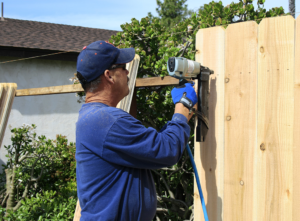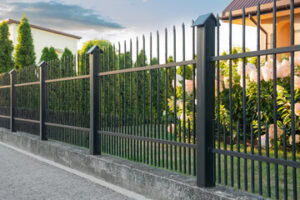Sun, wind, rain, snow, and ice affect wood fences. It’s best to repair fences with the most rot-resistant timber, such as pressure-treated lumber, which is saturated with preservatives and lasts nearly indefinitely even when buried underground.
First, to fix a leaning fence, clear away debris such as decorations or tree roots that may be pushing against the posts. Then, go against each post to see how much it gives.

No matter how well a fence is built, natural wear and tear can leave it in disrepair. Whether it’s an occasional hole or a section that falls, a few minor repairs may be all that’s needed to bring the entire fence back up to spec. However, replacing the deteriorated sections might be more cost-effective if the damage is severe.
Wood fences that have been exposed to excessive moisture can warp over time. Most minor warping can be corrected by heating the affected areas. Leaning or falling posts can also be a problem, but this damage may require substantial repairs and a professional’s services.
The cost to repair a sagging fence can range from $150 to $400, depending on the severity of the problem. Sagging usually occurs when the rails that support the fence screen become loose from the fasteners that secure them to the posts. Open rails can often be repaired by saturating the damaged area and the 2×4 scrap with a wood preservative and then nailing the 2×4 to the post for support. Alternatively, you can build a cleat underneath the loose rail by fitting it snugly with a 2×4 and then fixing it to the post.
Replacing a damaged panel in a wood fence requires a drill, a reciprocating saw, and some self-tapping metal screws. Start by unscrewing the panels from the metal fence rail brackets at one end of the panel. Next, remove the rest of the screw holding the panel to the remaining metal brackets at the other end of the panel. Pull the panel free, and let it fall onto the blocks you set in place on either side of the damaged panel and just under the bottom rail. Now, you can replace the panel and tap the new caps on the top of the post. The same process can be used to replace a damaged slat in a vinyl fence, but it’s a good idea to use the blocks for added support so that the replacement doesn’t eventually delaminate from the post.
The concrete footing at the base of a fence post prevents the posts from twisting, pulling, or leaning when a lot of weight is applied to them or when strong winds blow. If your fence post is counting, the concrete footing is broken or weakened and must be repaired before the fence can remain upright. You can do this independently if you dig up the post, break out the old concrete footing, and set a new footing. This is a large job and will take the most time of any of the fence repair projects.
It will help if you use pressure-treated timber for the new footing as it contains preservatives that make it last almost indefinitely, even when buried underground. If it is not too badly damaged, you can also save the existing post by digging it out of the ground and using a steel wedge repair bracket (available at home improvement centers) to hold it upright. At the same time, you pour in the new concrete footing.
Once you have the footing in, it is a good idea to reinforce the concrete with some reinforcing bars. This will ensure the footing is not weak and will be more resistant to water damage.
If you have trouble with a wood fence, try the EZ mender to mend loose or cracked panels. The EZ mender is a plastic product that expands when it comes in contact with water, so it helps to stiffen the panel and stop it from breaking apart. It is easy to apply, but it is only a temporary solution and will need to be replaced with stronger screws later.
The best fix for a leaning fence is to add support braces or lay a concrete foundation. These are more expensive projects than repairing holes or cracks, but they can keep your fence tall for years. Support braces cost between $60 and $150, while concrete foundations start at $125 per post and can run up to $2,300 for an entire fence, depending on the project size.
Wrought iron is a strong and aesthetically pleasing material for fences, gates, railings, and other home decor fixtures. However, wrought iron can develop rust spots, cracks, and breaks with time, like many metals. Homeowners can fix these minor problems, but more significant damage often requires the services of a fencing professional.
Cleaning: Wrought iron fences need regular cleaning to keep their appearance. A wall should be washed and rinsed well with mild soap and water. It’s best to use a power washer for this task, but if you don’t have one, you can clean the metal with a soft brush and a hose. It is important to remove all rust spots as they can cause the metal to crack, bend, and break over time.
Repainting: Over time, even wrought iron fences need to be repainted. This should be done with a paint that is rust-inhibitive and exterior-rated. Black enamel is typically preferred as it is “period correct” for historic homes, but you can choose any color you like.
Welding: The usual method for rejoining decorative sections of a wrought iron fence is to weld them, but this job should be left to a pro. Fortunately, you can make almost sturdy repairs with epoxy repair putty. After cleaning the area and removing all corrosion, mix the epoxy components according to the manufacturer’s instructions. Then, insert the new section into the hole in the post you dug out and backfill with tamped dirt or gravel.
When a wrought iron fence becomes bent, it can be very dangerous as it can allow unwanted guests to enter your property. Falling branches or other heavy objects usually cause this type of damage and may require the assistance of a professional. A bent rail can be replaced by removing the ties, holding it in place with linesman’s pliers, and then cutting both ends of the old rail. The crimped end of the new rail can then be slipped into one of the cut ends to re-secure it.
Some chain link fences should be more sturdy; if one of the rails gets bent, it can be very hard to straighten out. However, if it is only slightly bent, you can try to use a pipe wrench to pull or push on the damaged area of the rail. If this does not work, you must replace the damaged section of your fence rail.
Before removing the old rail section, you must assess the damage and figure out what caused the bending in the first place. You will also want to take this opportunity to ensure the rest of your fence is safe and secure.
Using a pair of pliers, you will need to remove the wire ties that connect the chain link mesh to the rails on either side of the damaged area. Once the ties are removed, you can detach the post from the fence fabric. You will also need to use the pliers to untwist and remove the metal wires from around the damaged area of the fence.
Once you have removed the old rail and know how much longer you will need to install a new one, you will be ready to go. Ensure that the new rail section is long enough to reach from an existing rail joint to at least six inches on each side of the bend. When cutting the new rail section, be sure to use a saw that can handle metal and is very sharp. You may need a helper at this stage to get the new section of rail installed in place.
Once the replacement rail section is in place, please attach it to the other end using a rail coupling. Then, you can slide the tapered end of the new rail into the end of the other rail and secure it with a rubber washer. Finally, you can tighten a rail cap to the other end of the rail.
